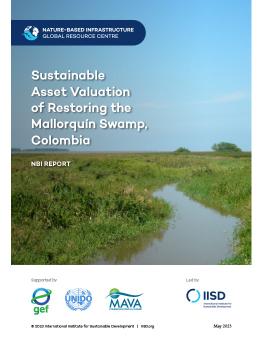
Sustainable Asset Valuation of Restoring the Mallorquín Swamp, Colombia
The assessment combines a spatially explicit analysis with a system dynamics model to quantify direct and indirect costs and benefits of mangrove restoration in the Mallorquín Swamp and grey infrastructure alternatives that provide similar benefits. This study demonstrates that the restored Mallorquín Swamp will provide multiple benefits, such as income from ecotourism and improved climate adaptation, including avoided flooding and erosion.
Barranquilla is Colombia’s fourth largest city, and population expansion in and around the city has created numerous environmental problems. For example, encroachment in the Mallorquín Swamp on the northern edge of Barranquilla has made residents more vulnerable to climate change and harmed livelihoods. Mangroves in the swamp have historically provided significant value by mitigating floods, protecting biodiversity and fisheries, storing carbon, and supporting tourism. However, urban development and waste disposal have damaged the ecosystem and limited the swamp’s capacity to provide these important services.
We conducted a sustainable asset valuation (SAVi) assessment of nature-based infrastructure (NBI) in the Mallorquín Swamp. Throughout the analysis, we engaged with World Resources Institute Colombia and Barranquilla Verde (the city’s environmental authority). The assessment incorporates a spatially explicit analysis with a system dynamics model to quantify the economic, environmental, and social impacts of mangrove restoration in Barranquilla. We used an integrated cost-benefit analysis to assess the monetized social, economic, and environmental outcomes of restoration over 20 years.
Key results:
- Restoration can counteract degradation and address environmental concerns.
- NBI in the Mallorquín Swamp creates more value for society at a lower cost than the grey infrastructure alternatives.
- The restored swamp could support the local economy and provide significant climate adaptation benefits.
- Supporting the local economy by providing a sustainable source of income increases the net value of the investment.
- NBI can be an effective long-term climate adaptation strategy.
- Investing in ecotourism infrastructure has a strong impact on the financial viability of the intervention.
- NBI is preferable to grey infrastructure from a financing perspective.
The report is complemented by technical appendices with methodological details about the system dynamics model and spatial analysis that were developed for the valuation.
Participating experts
You might also be interested in
IISD Annual Report 2023–2024
While IISD's reputation as a convenor, a trusted thought leader, and a go-to source on key issues within the sustainable development field is stronger than ever, the work happening outside the spotlight is just as valuable.
How to Make Nature-Based Solutions for Adaptation Work for Everyone
Effective nature-based solutions (NbS) for adaptation start with integrated climate risk assessments. These take-aways will help practitioners plan for inclusive and sustainable NbS.
Inclusive Nature-Based Solutions for Climate Adaptation
Discover how climate change and biodiversity loss impact people differently and how inclusive nature-based solutions for adaptation can help.
Nature-Based Solutions Inventory for Fiji
This inventory showcases the variety of nature-based solutions (NbS) projects (both completed and ongoing) being implemented in Fiji's ecosystems.